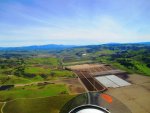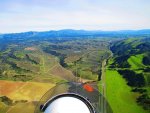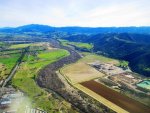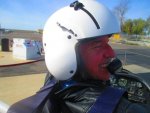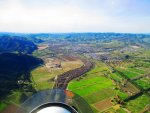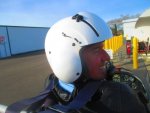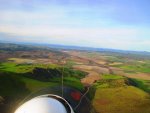- Joined
- Oct 30, 2003
- Messages
- 18,374
- Location
- Santa Maria, California
- Aircraft
- Givens Predator
- Total Flight Time
- 2600+ in rotorcraft
Dave is a primary student (no other rating) so he has specific things he is supposed to do before he can be signed off for his practical test. Most can be done in the pattern or in the practice area. In my opinion, one of the most important (and often neglected) is the cross country planning and then actually executing the plan.
This is where all the separate skills that have been learned are applied along with aviation decision making.
I feel there is a lot to be learned from this exercise and I have been accused of overemphasizing the importance and detail.
Flying is expensive and planning is pretty much free. I think of it as aviation foreplay. In my experience the more thorough the planning the more joy I find in the flight.
Dave seems to share my affection for good flight planning and he used flight planning tools like Google Earth, AirNav, Sky Vector and Flight Service extensively.
He marked up a Sectional Chart with his route and way points (typically every five miles) and had it available in a zippered plastic bag with his flight plan on the other side.
This would be his first time at a non-towered airport so we practiced radio calls a lot on the ground and sometimes on the actual flight.
Dave had already postponed his cross country flight once because he felt he was not ready so when he started to balk I reminded him: the more mistakes he made, the more and better he would learn. I was there to fix anything that put us at risk.
Life had gotten in the way and he had not flown for almost two months. I had him for half a day on Friday and all day Saturday, so Friday we practiced landings and reviewed his flight plan. We had intended to practice on the cross wind runway (2-20) at Santa Maria (SMX) because it is seventy five feet wide just like the runway at Santa Ynez so the site picture is different from the 150 foot wide main runway (12-30). We had some things to work out, because of his lack of recent experience, so we didn’t get around to landing on runway two zero. I had also changed the trim and that took some getting used to. We made seven landings in .8 hours. Dave has only landed on runway two zero once and that was with a seven knot direct cross. We decided two zero practice could wait till Saturday.
It will not be surprising, for those who have done their own cross country, that not everything went smoothly. We did ground till a little after five PM Friday so Dave could get started on refining his flight plan at his motel in Solvang. The power was out and he couldn’t even check in till near midnight and the internet was going to be down till at least one o’clock.
He got up at 5:00 and refined his plan so he could be at SMX at 9:00.
After going over his updated plan in detail, Dave did a careful preflight on The Predator before checking the weather. There was very little wind correction angle or changes in his estimated time in route, so we printed out his flight plan that he had done on power point so he could name his waypoints. I liked this lot. Sky Vector just has “user fix” waypoints in their nav log and is a good example of the way Dave makes the extra effort to excel.
Winds were calm and runway three zero was in use, so Dave asked ground for a takeoff from runway two zero and closed traffic. Ground was a little confused so I chimed in and explained the desire for the narrower runway.
Aviation people seem to know what an important milestone the first real cross country is and are all very supportive.
As I expected Dave made two nice landings and learned something on each one. Dave asked for a straight out with a turn to the south and it was approved as requested.
Dave was flying beautifully and appeared to be looking around more than usual. I could feel the confidence in his control inputs as we basked in the magic of the flight. The hills have greened up from the recent rains. The air was fresh and clean with a constantly changing aroma of the wet earth and whatever was growing there. Dave is a motorcyclist and The Predator was our motorcycle in the sky.
We were within a minute on the estimated time in route on each of his six waypoints and the sky was so clear he could usually see at least one waypoint ahead.
Dave found he had trouble writing and flying so I wrote down the time of arrival at the way points as he told them to me. Cockpit management is part of the learning process. Dave said he is going to practice flying with his left hand on the cyclic or learn to write with his left hand.
Dave did well with his radio calls knowing the reason for each piece of information and where the call should be made. Sometimes, in his effort to not waste airtime, he would get in a hurry and leave something out. It is just a matter of practice.
“Santa Ynez area traffic, white gyroplane Two Mike Golf, five miles to the west over the quarry at one thousand seven hundred feet inbound left traffic runway two six, slow moving sixty knots, Santa Ynez.”
We had examples of both good and bad radio calls at IZA reinforcing the value of a correctly made radio call.
We came in as nice as could be and were off at Charlie.
I had not briefed Dave enough about where to go after landing and Dave could see this was an important part of the planning process.
I could feel Dave’s elation as we pulled up to parking.
We spent nearly an hour applying the lessons learned to the plan for the next leg to Lompoc (LPC) and sharing Dave’s milestone with several friends in the pilots lounge.
We were within a minute of our estimated time of arrival and the fuel burn was exactly what it should have been. It was a good plan and well executed.
The rest of Dave’s story to follow.
This is where all the separate skills that have been learned are applied along with aviation decision making.
I feel there is a lot to be learned from this exercise and I have been accused of overemphasizing the importance and detail.
Flying is expensive and planning is pretty much free. I think of it as aviation foreplay. In my experience the more thorough the planning the more joy I find in the flight.
Dave seems to share my affection for good flight planning and he used flight planning tools like Google Earth, AirNav, Sky Vector and Flight Service extensively.
He marked up a Sectional Chart with his route and way points (typically every five miles) and had it available in a zippered plastic bag with his flight plan on the other side.
This would be his first time at a non-towered airport so we practiced radio calls a lot on the ground and sometimes on the actual flight.
Dave had already postponed his cross country flight once because he felt he was not ready so when he started to balk I reminded him: the more mistakes he made, the more and better he would learn. I was there to fix anything that put us at risk.
Life had gotten in the way and he had not flown for almost two months. I had him for half a day on Friday and all day Saturday, so Friday we practiced landings and reviewed his flight plan. We had intended to practice on the cross wind runway (2-20) at Santa Maria (SMX) because it is seventy five feet wide just like the runway at Santa Ynez so the site picture is different from the 150 foot wide main runway (12-30). We had some things to work out, because of his lack of recent experience, so we didn’t get around to landing on runway two zero. I had also changed the trim and that took some getting used to. We made seven landings in .8 hours. Dave has only landed on runway two zero once and that was with a seven knot direct cross. We decided two zero practice could wait till Saturday.
It will not be surprising, for those who have done their own cross country, that not everything went smoothly. We did ground till a little after five PM Friday so Dave could get started on refining his flight plan at his motel in Solvang. The power was out and he couldn’t even check in till near midnight and the internet was going to be down till at least one o’clock.
He got up at 5:00 and refined his plan so he could be at SMX at 9:00.
After going over his updated plan in detail, Dave did a careful preflight on The Predator before checking the weather. There was very little wind correction angle or changes in his estimated time in route, so we printed out his flight plan that he had done on power point so he could name his waypoints. I liked this lot. Sky Vector just has “user fix” waypoints in their nav log and is a good example of the way Dave makes the extra effort to excel.
Winds were calm and runway three zero was in use, so Dave asked ground for a takeoff from runway two zero and closed traffic. Ground was a little confused so I chimed in and explained the desire for the narrower runway.
Aviation people seem to know what an important milestone the first real cross country is and are all very supportive.
As I expected Dave made two nice landings and learned something on each one. Dave asked for a straight out with a turn to the south and it was approved as requested.
Dave was flying beautifully and appeared to be looking around more than usual. I could feel the confidence in his control inputs as we basked in the magic of the flight. The hills have greened up from the recent rains. The air was fresh and clean with a constantly changing aroma of the wet earth and whatever was growing there. Dave is a motorcyclist and The Predator was our motorcycle in the sky.
We were within a minute on the estimated time in route on each of his six waypoints and the sky was so clear he could usually see at least one waypoint ahead.
Dave found he had trouble writing and flying so I wrote down the time of arrival at the way points as he told them to me. Cockpit management is part of the learning process. Dave said he is going to practice flying with his left hand on the cyclic or learn to write with his left hand.
Dave did well with his radio calls knowing the reason for each piece of information and where the call should be made. Sometimes, in his effort to not waste airtime, he would get in a hurry and leave something out. It is just a matter of practice.
“Santa Ynez area traffic, white gyroplane Two Mike Golf, five miles to the west over the quarry at one thousand seven hundred feet inbound left traffic runway two six, slow moving sixty knots, Santa Ynez.”
We had examples of both good and bad radio calls at IZA reinforcing the value of a correctly made radio call.
We came in as nice as could be and were off at Charlie.
I had not briefed Dave enough about where to go after landing and Dave could see this was an important part of the planning process.
I could feel Dave’s elation as we pulled up to parking.
We spent nearly an hour applying the lessons learned to the plan for the next leg to Lompoc (LPC) and sharing Dave’s milestone with several friends in the pilots lounge.
We were within a minute of our estimated time of arrival and the fuel burn was exactly what it should have been. It was a good plan and well executed.
The rest of Dave’s story to follow.



